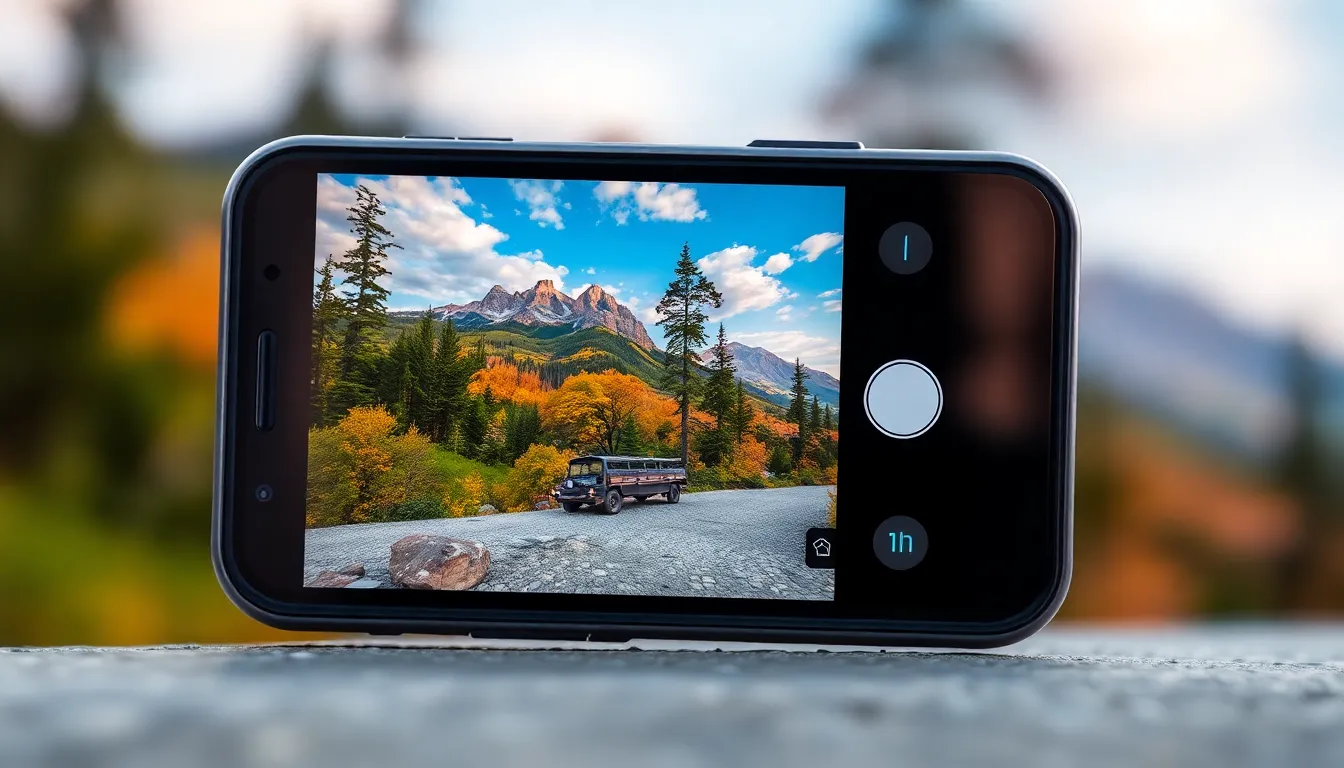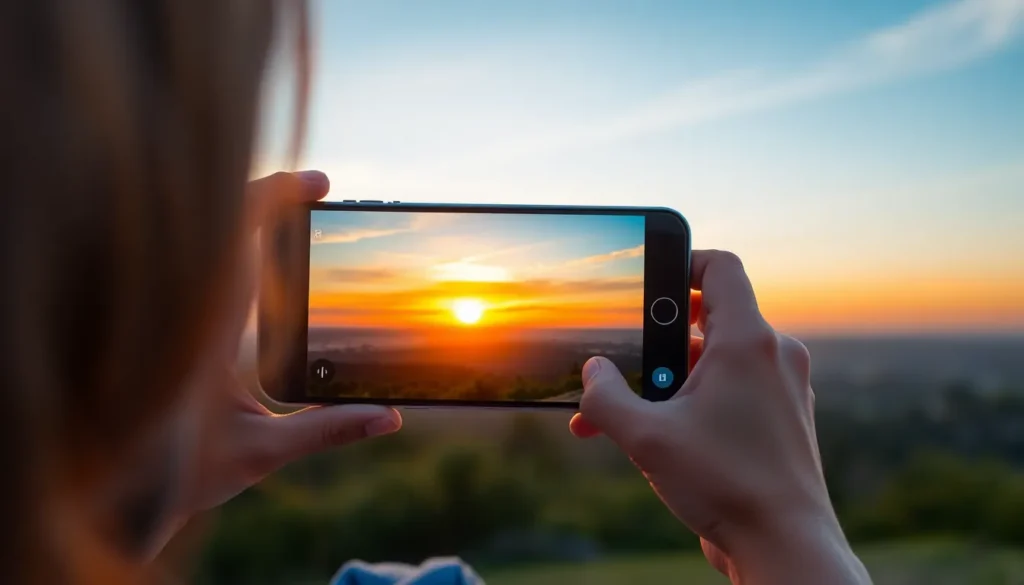Table of Contents
ToggleIn a world where every pixel counts and selfies reign supreme, the quest for the perfect smartphone camera is never-ending. Enter the iPhone, a device that’s become synonymous with quality photography. But does it have optical zoom? That’s the million-dollar question that has tech enthusiasts scratching their heads and photographers raising their eyebrows.
Imagine capturing that breathtaking sunset or your dog doing something utterly ridiculous from a distance without losing any detail. Sounds dreamy, right? While iPhones have made significant strides in camera technology, understanding how optical zoom fits into the picture is essential for anyone looking to elevate their photography game. So grab your favorite snack, sit back, and let’s dive into the optical zoom world on the iPhone—because who doesn’t want to get closer to their subjects without physically moving?
Overview of iPhone Camera Technology
Apple incorporates advanced camera technology in its iPhones. The camera setup varies between models, influencing features like optical zoom. Several iPhone models, including iPhone 7 Plus and later versions, feature dual-lens systems, enabling enhanced zoom capabilities. The primary lens captures wide-angle shots, while the secondary lens specializes in telephoto, providing a zoom function.
Optical zoom resolves images without losing quality. Users can zoom in on distant subjects, such as landscapes or wildlife, while retaining clarity. Different iPhone models offer varying levels of optical zoom ranging typically from 2x to 3x depending on the device. For example, when using the iPhone 11 Pro, users can access a 2x optical zoom through the telephoto lens.
Digital zoom exists as another option, allowing users to magnify images beyond optical limits. While digital zoom can capture distant subjects, it often results in loss of detail and clarity. Understanding the distinction between optical and digital is crucial for maximizing photography potential.
Night mode, portrait features, and computational photography also enhance the iPhone camera experience. These advancements enable users to take dynamic shots under various conditions. With each iPhone generation, Apple continues to innovate and improve camera functionalities, making it an ongoing competitor in smartphone photography.
Exploring the full capabilities of the iPhone camera can enrich a user’s photographic journey. Engaging with features like optical zoom and telephoto capabilities enables users to capture impressive images, supporting their creative expression.
Understanding Optical Zoom

Optical zoom enhances photography by allowing users to get closer to distant subjects without compromising image quality. Understanding this feature is crucial for anyone looking to maximize their iPhone’s camera capabilities.
Definition of Optical Zoom
Optical zoom refers to a lens mechanism that changes the focal length, allowing for clear, magnified images at a distance. Users benefit from this technology as it produces photographs with superior detail. iPhones typically offer optical zoom capabilities through telephoto lenses, which enable zoom levels of around 2x to 3x, depending on the model. This zoom type employs physical lens adjustments rather than software manipulation. Consequently, photos maintain clarity and sharpness, making them aesthetically pleasing for both casual and professional photographers.
Difference Between Optical Zoom and Digital Zoom
Optical zoom and digital zoom serve different purposes in photography. Optical zoom uses hardware adjustments through lenses for clearer zoomed-in shots. On the other hand, digital zoom zooms in on an image by cropping and enlarging it, which often leads to a loss of detail. Many users may prefer optical zoom for important captures like landscapes or portraits. Digital zoom provides convenience but compromises quality. Understanding these differences helps users choose the best zoom option for their photographic needs.
iPhone Models with Optical Zoom
Several iPhone models feature optical zoom, providing enhanced photography options. Users can capture detailed images of distant subjects with these advanced camera systems.
iPhone 7 Plus and Later Models
iPhone 7 Plus marked the introduction of dual-camera systems. The telephoto lens allows for 2x optical zoom, delivering clearer images at greater distances. Subsequent models, including iPhone X, XS, 11 Pro, 12 Pro, and later, feature similar systems. Each new generation enhances optical zoom capabilities, with certain models reaching up to 3x optical zoom. Photographers appreciate this technology for its ability to maintain image quality while zooming in on subjects.
Lens Specifications and Capabilities
Telephoto lenses in iPhones typically offer focal lengths between 52mm and 65mm. This range enables users to capture crisp details without compromising quality. The optical zoom feature operates through physical lens adjustments, significantly improving clarity. Users often rely on this capability for nuanced shots like portraits and landscapes. Alongside optical zoom, other features contribute to superior photography, including advanced image processing and low-light functionality.
To maximize the benefits of optical zoom, understanding individual iPhone model specifications assists users in selecting the best camera options for their needs.
Performance of iPhone Optical Zoom
The optical zoom functionality in iPhones significantly enhances photography. Various models demonstrate impressive image quality when zooming in.
Image Quality and Clarity
Image clarity remains one of the primary advantages of iPhone optical zoom. When utilizing optical zoom, users experience minimal loss in detail compared to digital zoom. This feature allows for closer shots of subjects, like landscapes or moving animals, without pixelation. Models equipped with 2x to 3x optical zoom maintain sharpness and vibrant colors, contributing to professional-looking photographs. Users appreciate the clean lines and natural appearance of images taken with optical zoom, as the adjustments in focal length ensure true-to-life representations.
Real-World Usage Scenarios
Real-world applications of iPhone optical zoom range from everyday photography to professional settings. Capturing distant subjects, like wildlife in a park, becomes straightforward with the telephoto lens. Photographers use optical zoom during family gatherings to get closer to moments without intruding. Landscapers find value in zooming in on breathtaking vistas or architectural details without sacrificing quality. The versatility of iPhone optical zoom enhances overall utility, making it ideal for various scenarios, including travel, events, and nature photography.
Comparisons with Other Smartphones
Many smartphones today feature optical zoom capabilities, creating competition in the photography space. Samsung’s Galaxy series, particularly the Galaxy S series, often includes telephoto lenses providing variable optical zoom, generally offering 2x to 10x zoom options. This flexibility in zoom range appeals to users seeking detailed images of distant subjects.
Huawei’s P series sets industry standards with exceptional optical zoom, especially in the P30 Pro. This model boasts a 5x optical zoom, with some modes allowing up to 50x digital zoom, significantly extending smartphone photography capabilities. Users embracing extensive zoom functions often find Huawei’s high-end models advantageous for various shooting situations.
Google’s Pixel devices focus on computational photography rather than hardware zoom capabilities. While lacking dedicated telephoto lenses, the latest Pixel models implement advanced digital zoom features, using software to enhance image quality. Users appreciate this emphasis on software processing, enabling impressive results even without dedicated optical options.
The OnePlus 9 Pro includes a 3.3x optical zoom, appealing to users desiring crisp details from their shots. Comparatively, the iPhone 12 Pro’s optical zoom offers similar capabilities, supporting a 2.5x zoom range. Users often weigh factors like image processing and overall camera ecosystem when choosing between these competing brands.
Current smartphone trends often prioritize multichannel camera systems, leading to improved optics. Understanding the differences in optical zoom between various brands helps users select the right device for their photography needs. With these advancements in optical technology, each smartphone brand strives to enhance user experience, setting evolving standards in mobile photography.
The iPhone’s optical zoom capabilities have significantly evolved over the years. With models like the iPhone 7 Plus and later versions offering enhanced telephoto functions users can now capture distant subjects with impressive clarity. This feature sets the iPhone apart in the realm of smartphone photography allowing for stunning images without the typical drawbacks of digital zoom.
Understanding the differences in optical zoom across various iPhone models empowers users to make informed choices based on their photography needs. As smartphone technology continues to advance the competition remains fierce but the iPhone’s commitment to quality photography remains a strong contender in the market.




